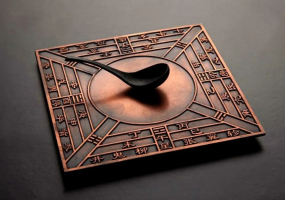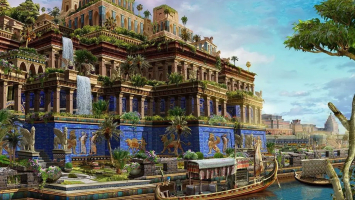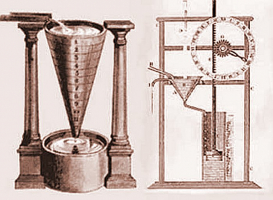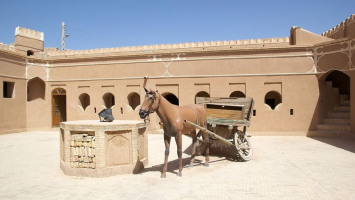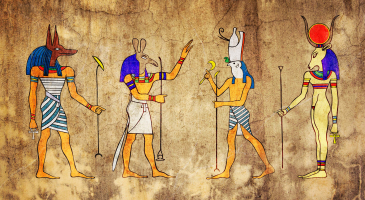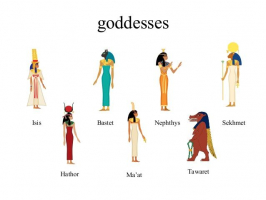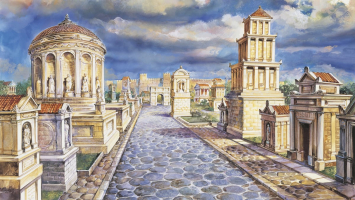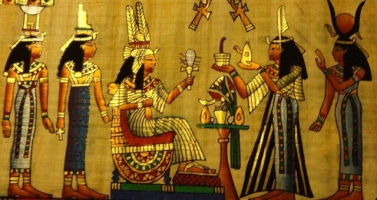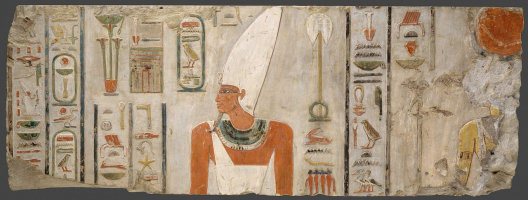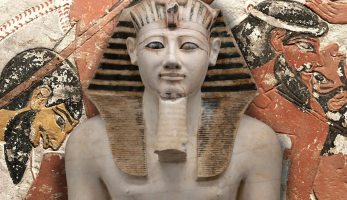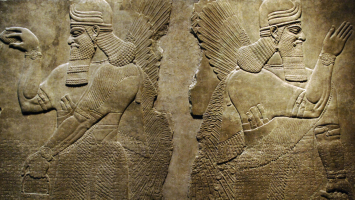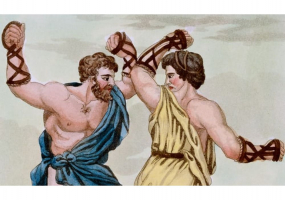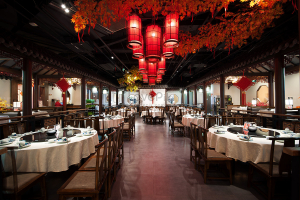Top 15 Ancient Egyptian Inventions and Discoveries
The ancient Egyptians were endowed with an incredible intelligence and a magical imagination, which resulted in ancient Egyptian innovations that were used to ... read more...experiment with various ideas in order to get a better grasp of the universe they inhabited. They devised means to elevate and document their lives, as well as numerous utilitarian devices that spread to other cultures. They made numerous outstanding contributions to language, mathematics, and science, which are gifts that keep on giving. The Ancient Greeks saw Egypt as a realm of mystery and wisdom, while the Ancient Romans were enthralled by Egyptian architecture and art. The ancient Egyptian civilization was the first to spin the wheel of innovation and originality, raising the bar for all subsequent civilizations. The following is a list of ancient Egyptian inventions and discoveries.
-
On the list of Egyptian inventions, the ancient pyramids are unquestionably at the top. They are solid geometrical formations with a square foundation and four equal triangle sides, making them some of the most amazing constructions in the entire world. Ancient conquerors and travelers were enthralled by the Egyptian pyramids, and today's tourists, mathematicians, and archeologists who visit to investigate, measure, and describe them are still in awe of them.
Early Egyptian rulers' tombs were bench-shaped mounds known as mastabas. Imhotep, King Djoser's architect, built the first pyramid around 2780 BCE by stacking six mastabas, each smaller than the one underneath, to make a pyramid rising in steps. This Step Pyramid is located near Memphis on the west bank of the Nile River in Sakkara. It, like later pyramids, has different rooms and tunnels, including the king's burial chamber.
During the reign of King Snefru, the founder of the Fourth Dynasty, the transformation from the Step Pyramid to a real, smooth-sided pyramid occurred (2680–2560 BCE). A step pyramid was created at Medum, which was then filled in with stone and capped with a limestone casing. Construction on a pyramid with smooth sides began nearby at Bahshur. However, around halfway up, the angle of the incline reduces from about 51 degrees to around 43 degrees, and the sides climb less sharply, giving origin to the name "Bent Pyramid." The modification in angle was most likely made during construction to increase the building's stability. A real, but squat-appearing pyramid was created at Dahshur by building a second great pyramid there with its sides rising at an inclination of slightly more than 43 degrees.
The Great Pyramid of Giza, the largest and most famous of all the pyramids, was erected by Snefru's son - Khufu, also known as Cheops, the later Greek variant of his name. The base of the pyramid stretched over 13 acres, while its sides rose at an angle of 51 degrees 52 minutes and were over 755 feet long. It was previously over 481 feet tall; it is now 450 feet tall. Scientists believe that its stone blocks weigh more than two tons on average, with the largest weighing up to fifteen tons. At Giza, two other large pyramids were constructed for Khafre (Chephren) - King Khafu's son, and Menkaure (Mycerinus) - Khafre's successor. The renowned Sphinx, a huge statue of a lion with a human head created during Khafre's reign, is also found at Giza.
Pyramids were not standalone structures; they were a part of a complex that included contained temples, chapels, additional tombs, and substantial walls. Funerary boat remains have also been discovered, with Giza having the highest preservation. The Pyramid Texts, a significant repository of knowledge about Egyptian religion, are inscriptions found on the walls of the Fifth and Sixth Dynasty pyramids. However, it is challenging to be certain of the specific burial practices or the uses of all the structures in the pyramid complex due to the dearth of historical records. The king's body is believed to have been transported by boat up the Nile to the location of the pyramid, where it was likely mummified at the Valley Temple before being interred.
Pyramid construction has given rise to rumors. The rather soft stone may have been cut using the copper chisels, drills, and saws that the Egyptians had at their disposal. A more challenging issue would have arisen from the use of hard granite for the walls of the burial chambers and some of the outer casing. With the drills and saws, workers may have employed an abrasive powder, such as sand. The orientation of the pyramids to the cardinal points required astronomical knowledge, and the perimeter was likely leveled with water-filled trenches. Large stone slabs were dragged on sleds over the ground that was first made slick by liquid, as depicted in a tomb picture of a gigantic statue being lifted. The blocks were then transported to their placements inside the pyramid by way of ramps. Finally, the outer layer of casing stones was built from the top down, and the ramps were demolished as the construction was completed.
The majority of the stone for the Giza pyramids came from the Giza plateau itself. Some of the limestone casing was carried from Tura, across the Nile, while granite from Aswan was used in a few of the rooms. Quarry workers' marks, such as "craftsman-gang," may be found on some of the stone blocks, along with the names of the work gangs. Part-time labor teams most likely complemented the year-round masons and other skilled workers. In the fifth century BCE, the Greek historian Heroditus wrote that his Egyptian guides told him that 100,000 men were employed three months a year for twenty years to build the Great Pyramid; contemporary estimates of the number of employees are substantially lower.
The Fourth through Sixth Dynasties saw the peak of pyramid construction. Long after the first millennium, smaller pyramids were still being constructed. Many of them have been found, but many more likely still have their bodies buried beneath the sand. Later rulers were interred in secret tombs carved into rock cliffs as it became obvious that the pyramids did not offer protection for the mummified bodies of the kings but rather were obvious targets for grave robbers. Although the Egyptian rulers who built the majestic pyramids did not have their bodies protected by them, the pyramids have succeeded in perpetuating their names and histories.National Geographic's Channel 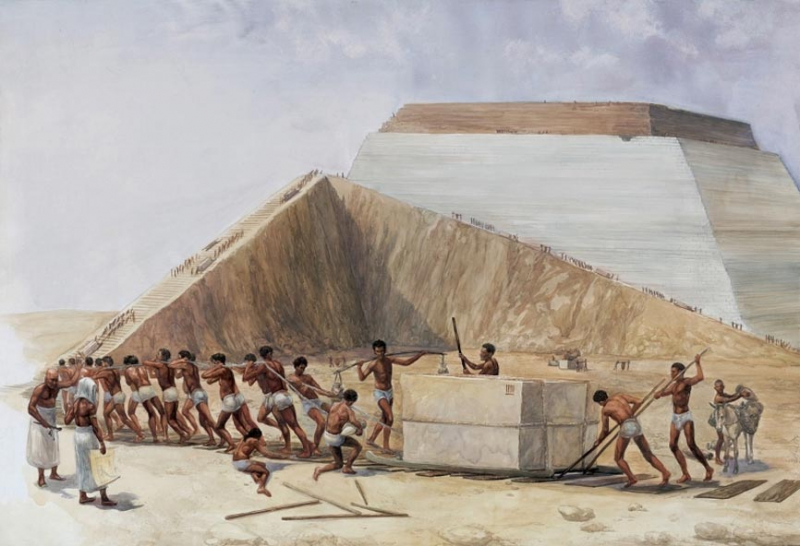
Demystifying the Egyptian Pyramids with Hard Facts - Ancient Origins -
Earlier civilizations, such as those that evolved in Mesopotamia, viewed physical and mental disorders as the work of the gods and attempted to treat them with religious and magical medicines administered by priests or even exorcists. Medicine, as we know it today, originated in ancient Egypt. Although the supernatural continued to play a significant role in their understanding of health, the Egyptians took a considerably more scientific approach to cure illness, developing medications from natural resources such as minerals, plants, and animal products, and performing early types of surgery. As early as 2200 BC, there were organizations known as Houses of Life where doctors and priests practiced medicine. These facilities, which are committed to enhancing and safeguarding human life, might even be viewed as a precursor to hospitals.
They spent a lot of time learning about the art of human anatomy, which dates back to 3000 B.C.E. Egyptian physicians were well-known for their ability to amputate limbs, mend shattered bones, and patch up wounds in the ancient world. Opium was utilized as a painkiller, and they regularly ate foods like onions and garlic for their health benefits. Due to their intense concern for maintaining good dental hygiene, they were the first to develop and utilize a toothbrush and toothpaste. They employed numerous herbs to cure wounds and performed quite intricate surgeries using several bronze surgical tools since the word surgery was first mentioned in ancient papyrus about 2700 B.C.E. For all of these reasons, Egyptian doctors were well-known throughout the Mediterranean.
Not only did the Egyptians pioneer a plethora of innovative medical concepts, but they also established the world's first public health system. Around 1500 BC, the settlement of Deir el-Medina was founded for the craftsmen and laborers working on the nearby Valley of the Kings' royal tombs. These workers received a shared doctor to take care of their medical issues and aid in the healing of any complaints in addition to their monthly income, food supply, and servants. The laborers may have continued to collect their meals even when they were ill: this is the earliest known instance of sick pay! As good-natured as this may sound, it is crucial to keep in mind that the pharaohs only instituted this system in order to guarantee a steady supply of laborers to build their spectacular tombs.
Nevertheless, the advancements gained in sanitation, diagnosis, and treatments demonstrate how much contemporary medicine owes to the discoveries and knowledge acquired by the ancient Egyptians.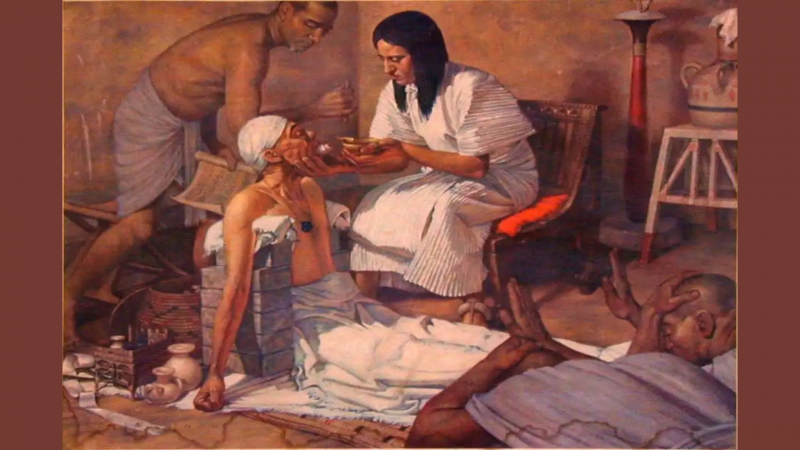
Lithograph depicting an ancient Egyptian physician for lockjaw - Smithsonian Magazine, Washington D.C. 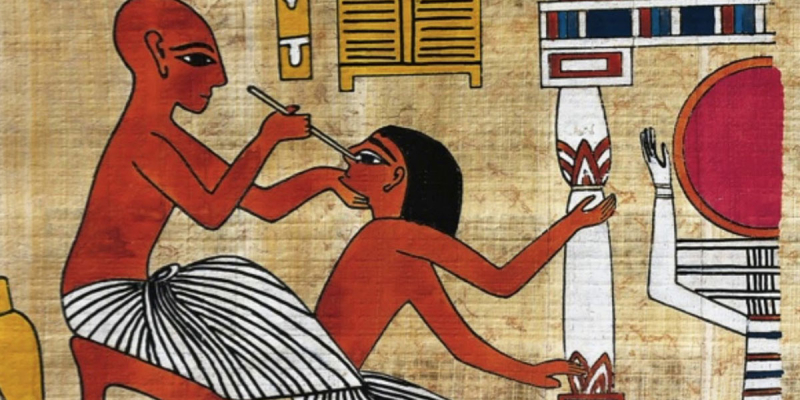
Ancient Egyptian Medicine - Doctors in Ancient Egypt - Ancient Egyptian Diseases - Egypt Tours Portal -
For individuals who did not have a private police force to defend their homes, there was another option: initially, dwellings and structures were protected by a simple bolt placed across the door, but around the second millennium BC, the Egyptian inventions of lock and key became the new security methods.
The ancient Egyptian tumbler lock symbolizes a fundamental transition in engineering history, despite being unquestionably less complicated than contemporary keys. When the correct key was entered, its prongs lifted up to allow the bolt to be drawn back and the door to open. Inside, many pins created a series of miniature bolts. The size of these old locks was one disadvantage. The first versions of these were huge, occasionally 2 feet long, and fashioned of wood. However, locks were not widely utilized throughout the Egyptian era, unlike furniture and cosmetics. Locks, like furniture and cosmetics, were not widespread throughout the Egyptian period; they were mostly employed to safeguard the wealthy's apartments and valuables, and have even been discovered inside the vast pyramids that functioned as the tombs of Egypt's kings.
Egyptian locks were actually more secure than Roman locks, which used a simpler design with a spring rather than a bolt to hold the door in place. The Roman locks were hidden inside the door, although they were comparatively easy to pick in comparison to the Egyptian locks.
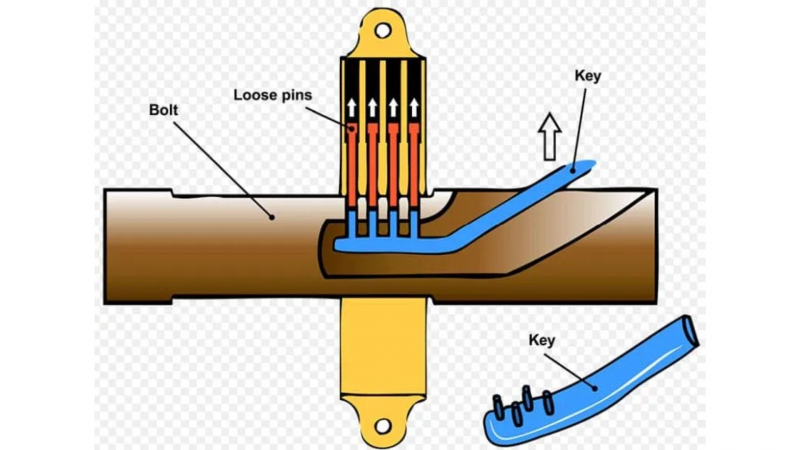
Reconstruction of the ancient Egyptian door lock. - Wheaton Lock Service 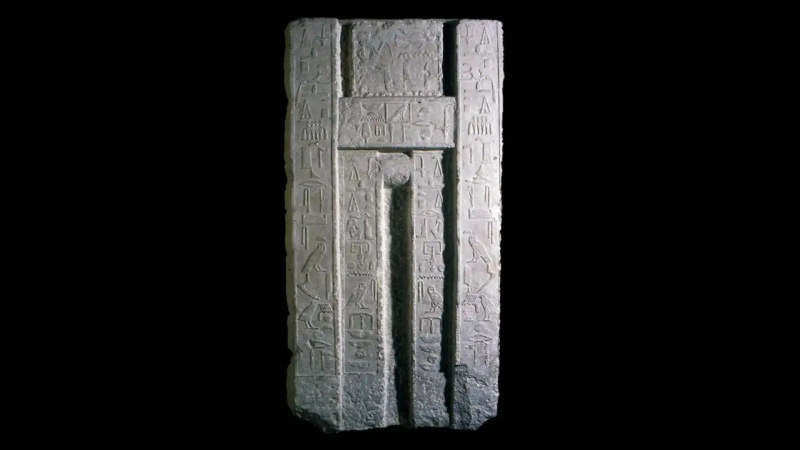
Limestone false door of Inti - Harvard University Digital Giza, Cambridge -
During the Old Kingdom period, the Egyptians, like most ancient societies, relied on local warriors and privately employed guards (paid by rich landowners and nobles) to protect their fortresses, holy buildings, and, more significantly, storehouses. However, by the conclusion of this epoch, particularly during the 5th Dynasty, the Egyptian monarchy and nobility began to hire more committed personnel for essential guarding jobs. The majority of these guards were drawn from military factions, ex-military veterans, and even international mercenaries. One of the most notable instances would be the elite Medjay, who were essentially Nubian desert scouts entrusted with protecting high-value public buildings such as markets and temples.
Since the first police force was established in ancient Egypt, the growth of urban living and the concentration of power coincided with the emergence of organized law enforcement. Around 2500 BC, it was first used to patrol and control the ships and boats traveling on the Nile, guard them against robbers, and guarantee that trade and the economy remained prosperous. Around 1500 BC, the Egyptians created the Medjay, an elite paramilitary police unit. A nomadic group from Nubia who served as the first police officers were referred to as "Medjay," but the term quickly came to be used to refer to the entire force. The Pharaoh's palace, frontiers, and capital city were among the most important places the Medjay were tasked with guarding.
Thus, in the sphere of personal security, ancient Egypt established the world's first recognized police force. By the Middle Kingdom (approximately 2050 - 1800 BC), the overlapping system of employing soldiers (or ex-soldiers) as guards had been replaced by developing a full-time professional police force. These ancient Medjay 'cops' were entrusted with ensuring peace in their various zones and protecting commerce caravans, in addition to guarding crucial and high-value sites. They approached this mission in a variety of ways, including the use of animals such as dogs and even monkeys to apprehend offenders. And, similarly to today, the rising police force was fueled by a state-administered body that chose the Chief of the Medjay. The Chief of the Medjay, in turn, appointed his sub-chiefs, who then appointed their deputies and constables in specific precincts across the city.
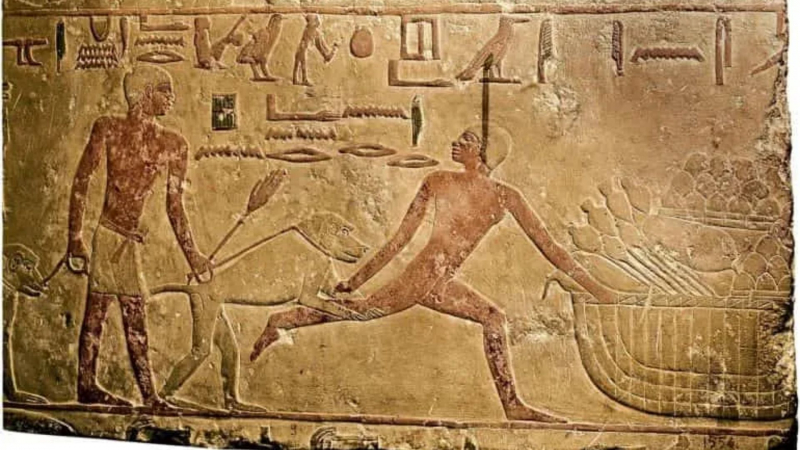
An Egyptian policeman along with a dog catching criminal - Reddit 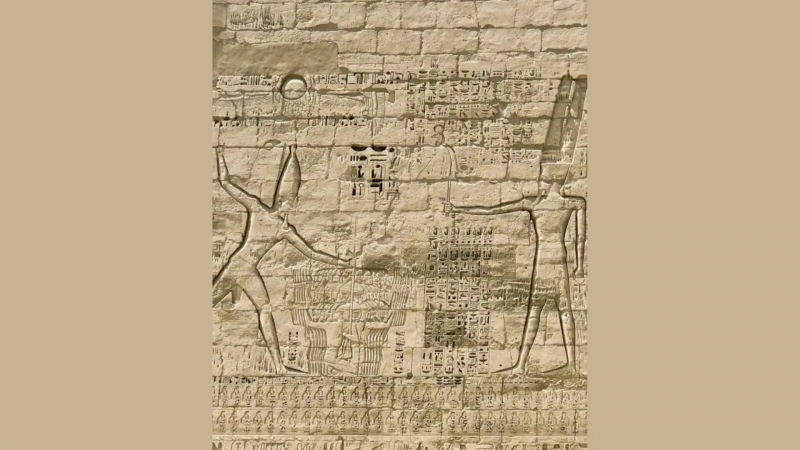
Relief of Ramesses III slaying prisoners at Medinet Habu - Brigham Young University, Provo -
The modest chair and table may appear to be a rather commonplace item in daily life. But before the introduction of tables and chairs by the ancient Egyptians, people just sat on the ground or on short stools, and they utilized big blocks or crude benches as surfaces. Then, in the middle of the third millennium BC, a burst in the furniture arts occurred as Egypt started to produce pieces with elaborate carvings.
Egyptian tables were often built of wood and alabaster, and they had a smooth platform lifted off the ground by either a pedestal or legs, which were occasionally distinct or detachable parts. There is evidence that early tables were used for board games, writing, and other activities similar to those done at current tables.
The Egyptian chair, on the other hand, was rather unique. It was a status symbol, a luxury enjoyed only by the rich, rather than a universal item of household furniture found in any home or public space. While peasants and farmers sat on stools, affluent and royal Egyptians sat on real chairs with backs and armrests. Ancient chairs made of valuable materials like as ivory and ebony, ornamented with expensive metals, and delicately decorated with carved figurines of animals, plants, or deities have been uncovered.
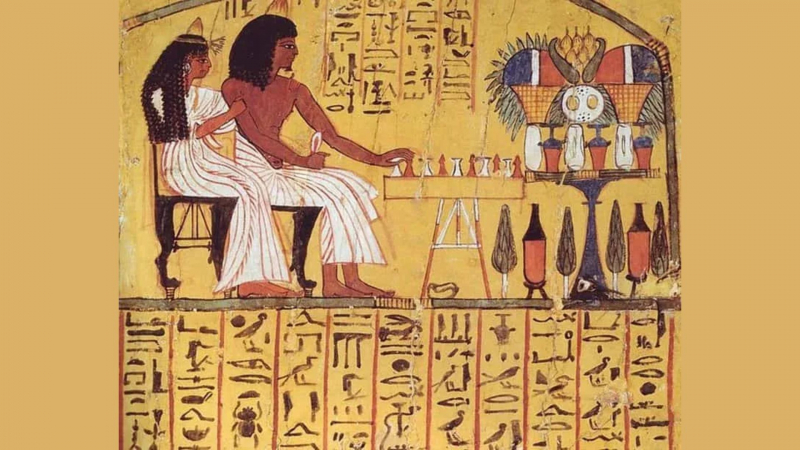
Pinterest 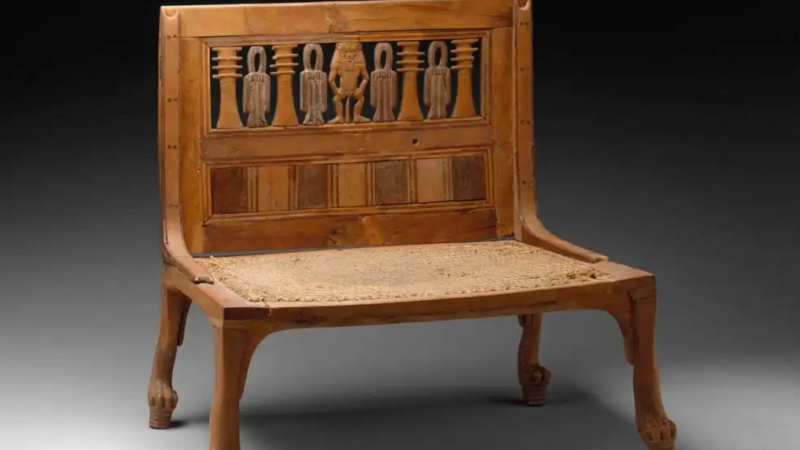
Hatnefer’s Chair, 1492-73 BC - The Metropolitan Museum of Art, New York -
In terms of time, the Mesopotamians pioneered the way by devising the sexagesimal system. However, today's identifiable calendar and timekeeping technologies were invented by the Egyptians. The Egyptian calendar was divided into twelve months of 30 days each, with five more days added at the end of the year to bring the total up to 365. It is clear that this invention has withstood the test of time. Unlike us, the Egyptians recognized only three seasons, which farmers used to predict when crops were to be sown and harvested.
The Egyptians classified time into three major periods: the flood season (akhet), which lasted one-third of the year; crop sowing and growth (perit); and harvest (shemu). These three seasons each lasted 120 days and comprised one calendar year. They chose the rising of the Dog Star, which is visible to the naked eye, to mark the start of each year. After a while, it became clear that the calendar was too short, but the civil year began at the same time as the agricultural year.
The Egyptians not only invented the days, months, and years that we still use today, but they also invented the first timepieces. The earliest known sundial, discovered in 2013, was uncovered in the Valley of the Kings and dates from around 1500 BC. However, this was not the first instance of a timekeeping device. Huge obelisks, originally built 2000 years ago, were used to tell the time by the way their shadows fell across its carvings, and the Egyptians invented the water clock at the same time as the first sundial. Knowing the time provided a significantly more structured and efficient civilization, implying that the invention of these gadgets may have enabled many of the other breakthroughs achieved by the ancient Egyptians.
Later, they created the first portable shadow clock that was portable and lightweight enough for people to carry. The time was indicated by the shadow of a rod that had 12 parts on it. The reigns of each king were also documented in records and historical documents.
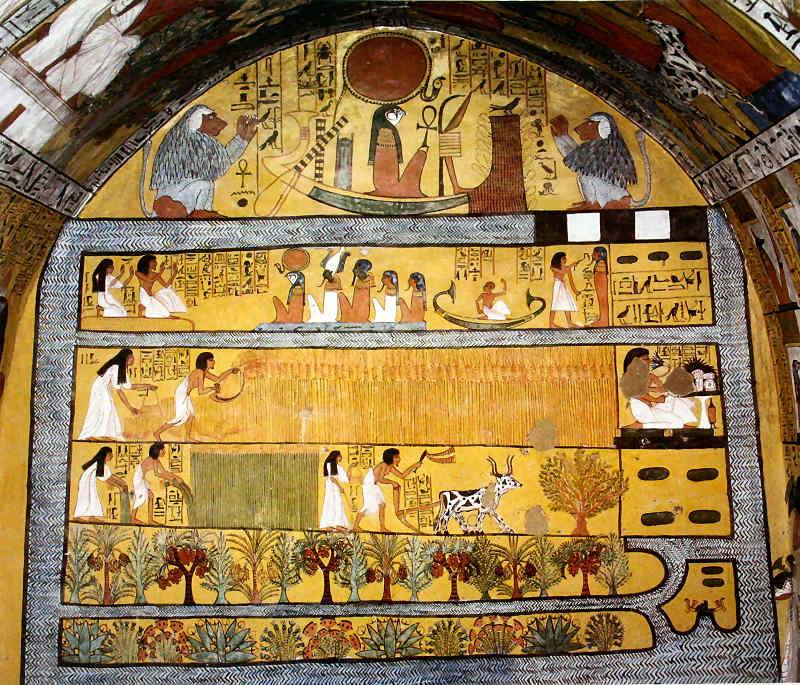
Harvest Scene on the East Wall Tomb of Sennedjem - Egypt Museum 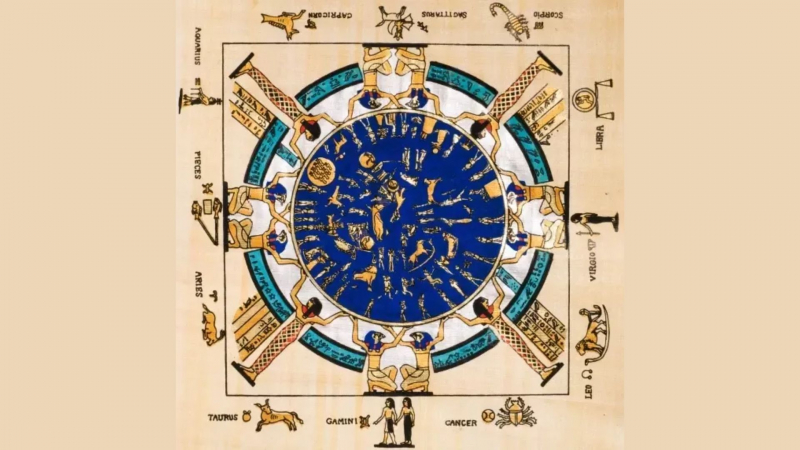
Quora -
People's time and effort had been tied up with the essentials of existence, procuring food and shelter for survival, with little time for anything else, for most of human history prior to ancient Egyptian civilization. However, as urbanization occurred, first in the Middle East and then in Egypt, and organized structures were put in place to care for the daily lives of their residents, we see the concepts of leisure and recreation emerge. As the set of skittles below clearly shows, people now had the time and energy to look beyond their fundamental needs.
This new fashion also made the Egyptian inventions of cosmetics and beauty regimens visible. Being attractive to the other sex has undoubtedly always been a priority for humans, whether this is due to biological factors, unconscious motivations, or conscious choices. However, the ancient Egyptians went a step further by creating a variety of rituals and products that highlight a woman's appearance. Beauty became a top priority for the affluent women of ancient Egypt who did not have to work, from shaving off undesirable hair with a wax-like substance made of sugar to enhancing facial features with makeup created from natural colors including crushed beetles and deadly lead.
Even while the invention of eye makeup may not be as significant as the invention of fire or the wheel, it nevertheless gives the Egyptians a run for their money. Eye makeup has never gone out of vogue since it was created in 4000 BCE. Even more astounding, certain aesthetically oriented societies continue to use the same methods developed by the Egyptians thousands of years ago to produce cosmetics. They created the black ointment known as kohl, which is still widely used today, by combining soot with a mineral known as galena. By tinting, the ointment with a mineral called malachite and galena, they could also manufacture green eye makeup.
Makeup was not just used by women in Egypt. Status and attractiveness went hand in hand, and the more cosmetics the better for the higher class. The Egyptians' renowned heavy touch with eyeliner was due to more than just fashion. They also believed that applying a thick coating of the substance might cure different eye problems and even protect them from the evil eye.
Wealthy Egyptians lived a refined lifestyle that represented their social level, therefore they paid close attention to their personal appearance. Wigs were very popular among Egyptian women. Wigs were frequently worn not only for fashion but also for protection, as individuals needed to protect their skin from the arid climate and harsh sun. While the most affordable and widely accessible wigs were made of vegetable fibers, the royal family had theirs manufactured entirely of human hair, frequently from Nubian peoples, to mimic the Afro style prominent throughout the second millennium BC.
The Egyptians were also known for their perfumes, which were manufactured from ingredients such as lily oil. Razors or depilatory treatments were used to eliminate body and facial hair. It's fascinating to note that both sexes wore make-up and wigs.
It comes as no surprise that Cleopatra was regarded as one of history's most gorgeous women. Many of her techniques, such as apple cider vinegar as a face toner, milk and honey baths to soften the skin, aloe vera for hydrating, natural henna for nail color, almond oil for younger skin, and honey for smooth hair, are still used today.
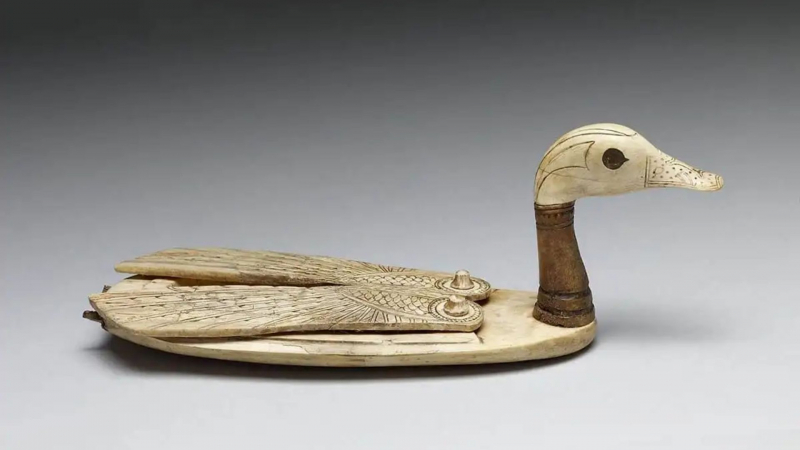
Duck Cosmetic Box, 1550-1196 BC - The Walters Art Museum, Baltimore 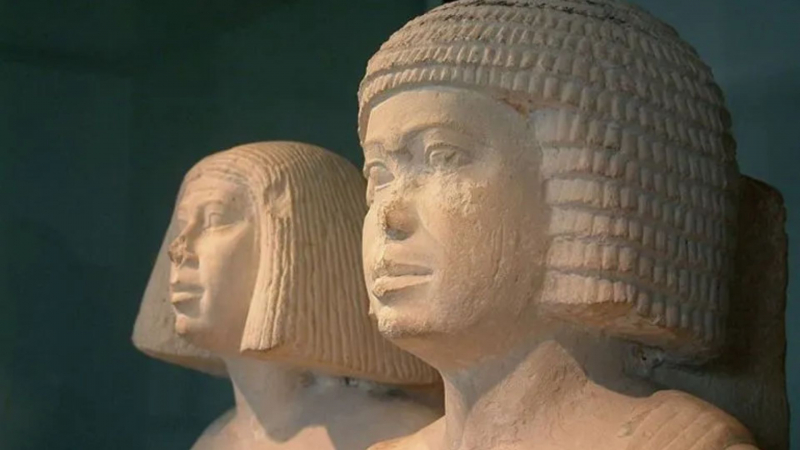
Formal wigs worn by an Egyptian couple of 5th dynasty, circa 24th century BC. - realmofhistory.com -
The development of paper and ink, which we today see as essential to the written word even though writing predates the Egyptians, was a product of their civilization. It was not paper as we know it now, but a predecessor was known as papyrus, which took its name from the green reeds that flourished along the Nile.
For many years, historians have been attempting to figure out exactly how the Egyptians turned this plant into a writing surface, but the records are frustratingly hazy. However, it is believed that the first step entailed cutting the stem into strips, which were then soaked to extend the fibers and placed down in overlapping layers. They were then crushed, either hammered, rolled, or pressed, until the layers fused to form a flat surface, but ancient papyrus was far from smooth. Because of the dry Egyptian climate, documents created of papyrus lasted a very long time.
However, until there was a means to write on it, all that papyrus was useless. The Mesopotamians carved their letters into clay, stone, and wax, but the Egyptians used ink, which was less laborious. They created this by blending a variety of colors and ores with water to create a thick liquid that could be applied to papyrus using a brush or stylus. The Egyptians were able to manufacture ink in a variety of colors by combining natural substances such as copper, iron, quartz, and malachite, though black, red, and blue are the most prevalent.
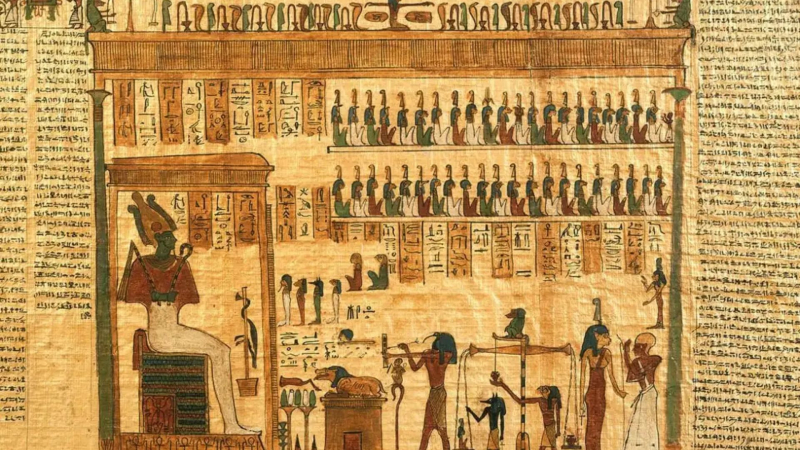
Page 125 of the Papyrus Book of the Dead entitled ‘The Weighing of the Heart’ - University of Chicago Teaching of the Middle East 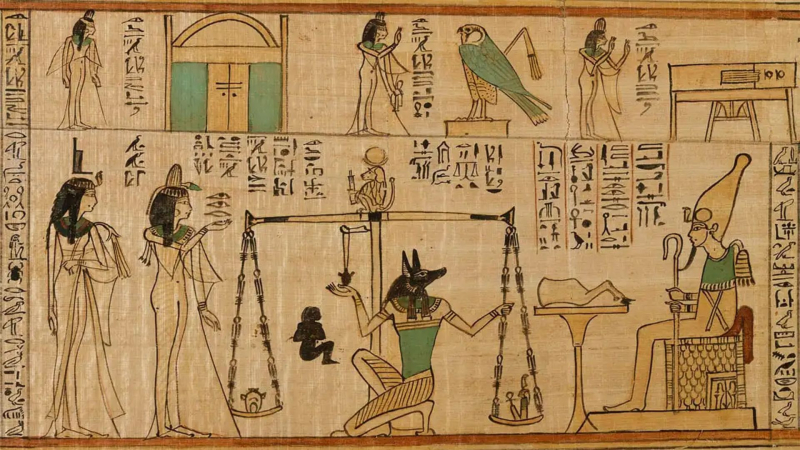
Book of the Dead for the Chantress of Amun, Nany, 1050 BC - The Metropolitan Museum of Art, New York -
In the early nineteenth century, British archaeologist William Matthew Flinders Petrie oversaw a number of significant excavations in Egypt, excavating nearly 3000 ancient graves filled with personal goods and items to guard the spirit in the afterlife. Unfortunately, many of these tombs belonged to youngsters, and it was in one of these that Petrie discovered one of his most astonishing finds: a set of skittles. The 5200 BC tomb contains a number of balls and nine stones shaped like vases, according to Petrie. Initially mistaking these for ornaments, archaeologists eventually recognized they had unearthed the oldest traces of bowling, one of the most unexpected ancient Egyptian discoveries.
The ancient game, which is thought to have been somewhat different from the controlled and frequently intensely competitive version played today, reportedly just included hurling a ball at a group of immovable objects at a set distance. It is improbable that they had designated playing areas or "alleys" or that there was a mechanism to ensure the regularity of the pins. The balls could be constructed out of stone or even porcelain, but they were typically formed from corn husks that had been coated in leather and bound with twine. Other ancient civilizations, such as the Romans, later adopted the crude version of bowling that the Egyptians loved, and it eventually evolved into the game that we still play today.
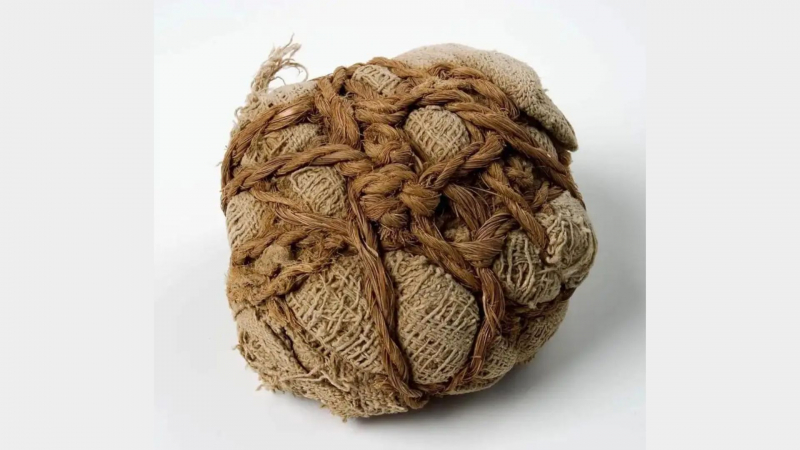
Ancient linen ball from Grave 518 at Tarkhan, Egypt, usually used for Games - Bristol City Museum and Art Gallery 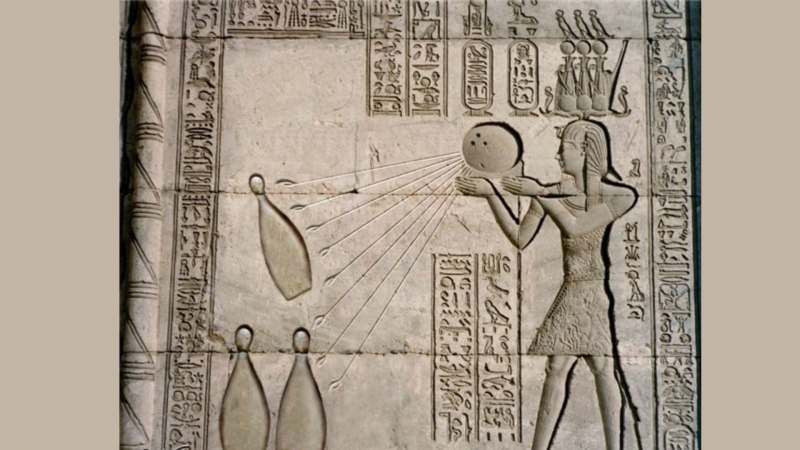
Eden SuperBowl's Facebook -
Mummification describes the techniques the ancient Egyptians employed to treat or embalm a corpse. The Egyptians used unique techniques to completely dry out the body, leaving behind a dried form that would not quickly decompose. Their faith stressed the importance of keeping the corpse as lifelike as possible. They were so prosperous that, three thousand years later, we can look at an Egyptian's mummified body and get a fair picture of how they appeared in life.
Mummification was practiced for the majority of Egyptian history. The earliest prehistoric mummies were most likely unintentional. Because Egypt has almost no measurable rainfall, dry sand and air preserved some bodies buried in shallow trenches excavated into the sand. Egyptians most likely began actively mummifying the deceased around 2600 BCE, during the Fourth and Fifth Dynasties. The practice persisted and evolved for nearly 2,000 years, well into the Roman period (ca. 30 BCE–CE 364). The quality of mummification varied over time, depending on the amount paid for it. Mummies from the Eighteenth through Twentieth Dynasties of the New Kingdom (ca. 1570-1075 BCE) are the best prepared and preserved and include Tutankhamen and other well-known pharaohs. Here, the overall course of this time period will be described.
The process of mummification takes seventy days. Special priests handled and dressed the body as embalmers. The priests required a thorough understanding of human anatomy in addition to knowing the proper rites and prayers to be said at different times. All internal components that might degrade quickly were removed as the initial step in the procedure. The brain was extracted by delicately pulling out pieces of brain tissue with special hooked devices that were inserted up through the nose. It was a delicate procedure that might easily leave the face disfigured. The abdominal and chest organs were then removed by the embalmers using a cut that was often performed on the left side of the abdomen. They only left the heart in place because they believed it was the center of a person's being and intelligence. The stomach, liver, lungs, and intestines were stored individually in special boxes or jars known today as canopic jars. These were interred alongside the mummy. Organs were treated, wrapped, and replaced within the body in subsequent mummies. Even yet, unused canopic jars were still used in the funeral process.
Following that, the embalmers eliminated all moisture from the body. This was accomplished by covering the body with natron, a form of salt with excellent drying characteristics, and inserting additional natron packets within the body. After the body had completely dried out, embalmers removed the inside packets and gently rinsed the natron off the body. As a result, a severely dried-out but recognizable human figure resulted. Sunken portions of the corpse were covered in linen and other materials, and artificial eyes were placed to make the mummy appear more lifelike.
Then the wrapping started. Several hundred yards of linen were required for each mummy. Long strips of linen were painstakingly twisted around the body by the priests, who occasionally wrapped each finger and toe individually before encircling the entire hand or foot. Amulets were interspersed with wrappings, and some of the linen strips had prayers and mystical writing on them to protect the dead from misfortune. Between the layers of headbands, the priests frequently inserted a mask of the person's face. The form was covered with warm resin at various points, and wrapping resumed. The priests finally placed the last shroud in place and fastened it with linen strips. The mummy had been finished. During this period, the priests who were preparing the mummy were not the only ones who were active. Although tomb preparation had normally begun long before the person's death, there was now a deadline, and craftsmen, laborers, and artists had to work rapidly. There was a lot of stuff to put in the tomb that a person would require in the hereafter. Furniture and statuettes were made; wall paintings of religious or daily subjects were completed, and meal or prayer lists were completed. When needed in the Afterlife, these models, photos, and lists would become real through a miraculous procedure. Everything had been prepared for the funeral.
Priests performed special religious procedures at the tomb's entrance as part of the funeral. The most essential aspect of the ceremony was known as the "Opening of the Mouth," in which a priest used a special instrument to "open" certain sections of the mummies to the senses enjoyed in life and required in the Afterlife. The deceased individual might now speak and eat by touching the gadget to his or her mouth. He was finally prepared to embark on his voyage to the Afterlife. The mummy was placed in his or her coffin(s) in the burial room, and the entrance was sealed.
Such elaborate burial traditions may indicate that the Egyptians were preoccupied with death. Because of their enormous love of life, they began making provisions for their death early on. They could think of no finer life than the one they were living, and they wanted to ensure that it would continue after death.
But why preserve the body, exactly? The mummified body, in the eyes of the Egyptians, served as the dwelling place for this soul or spirit. The spirit might be lost if the body were to be destroyed. Three spirits - the ka, ba, and akh - make up the complicated concept of "spirit." The sacrifices and items were needed at the tomb because the ka, a "double" of the deceased, would stay there. The ba, or "soul," had free rein to leave and enter the tomb. And the entity that had to pass through the Underworld to reach the Final Judgment and entry to the Afterlife was the akh, which is likely best translated as "spirit." All three were crucial to the Egyptians.
Egyptian pharaohs were frequently mummified and buried in ornate tombs after death. Members of the nobility and officials, as well as commoners, were frequently subjected to the same treatment. However, the procedure was prohibitively pricey for many people. Some animals were also mummified for religious reasons. The early dynasties' sacred bulls had their own graveyard in Sakkara. Baboons, cats, birds, and crocodiles, which had sacred importance as well, were sometimes mummified, particularly in the latter dynasties.
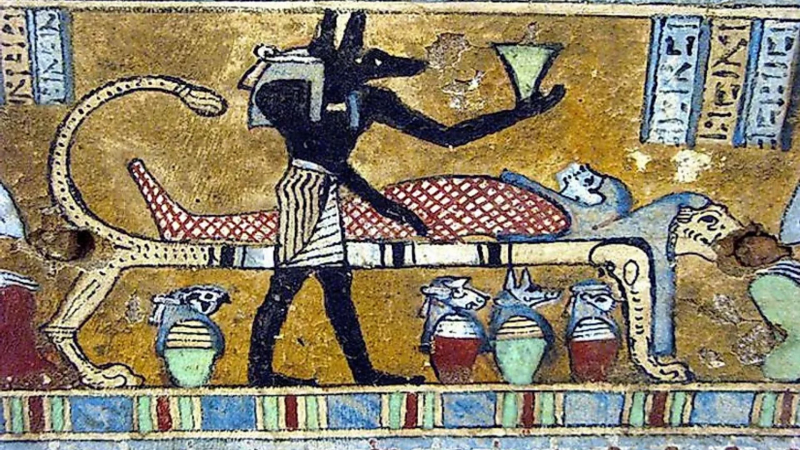
Anubis, the Egyptian God associated with mummification and afterlife is depicted in a painting with the body of the deceased. - worldatlas.com 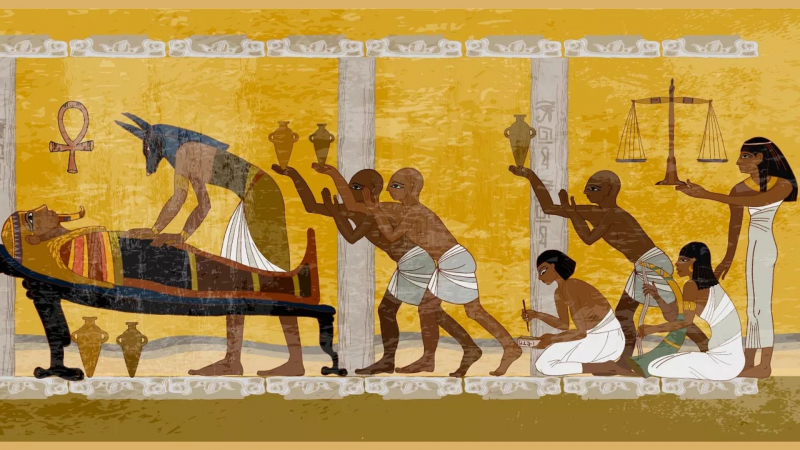
The History of Mummification in Ancient Egypt - Wondrium Daily -
The extraordinary preservation of the bread over thousands of years reveals one thing: Egyptian granaries and bakeries could not have passed a current health inspection. The consumers' teeth's enamel was worn away by the bread's abundance of grit and stone chips, leading to a wide range of dental problems. Ancient Egyptians frequently suffered from abscesses, therefore toothpaste emerged as one of their most famous innovations to help those who could afford it avoid them.
Egyptian toothpaste was created by grinding and combining various salts, dried flowers, pepper, ashes, and even eggshells. This abrasive mixture was then massaged in with the finger or a rudimentary toothbrush composed of torn twigs. Although it cleaned the teeth remarkably well, the toothpaste may have done more harm than good due to its gritty texture, which caused bleeding gums.
The Egyptians also invented breath mints for people who fell victim to the dangers of dental disease. Ancient Egyptians used drops of boiled honey infused with fragrant herbs and spices like frankincense, myrrh, and cinnamon to mask the unpleasant odor of decaying teeth. Additionally, they included mint in their toothpaste to freshen the breath - a practice that is still common in dental goods today.
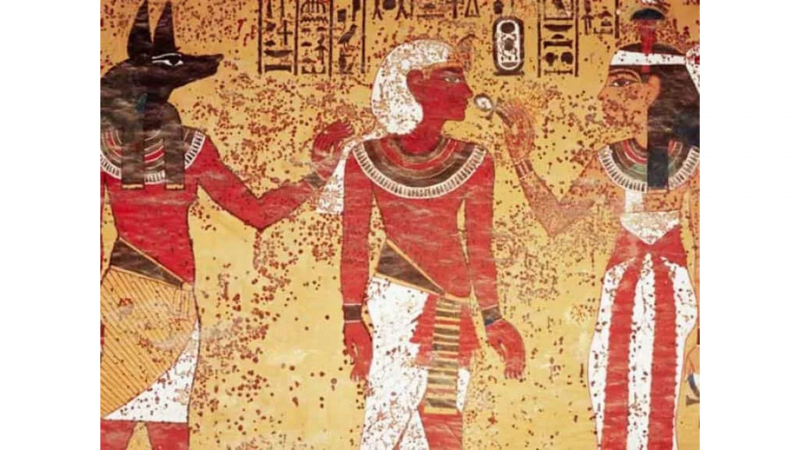
realmofhistory.com 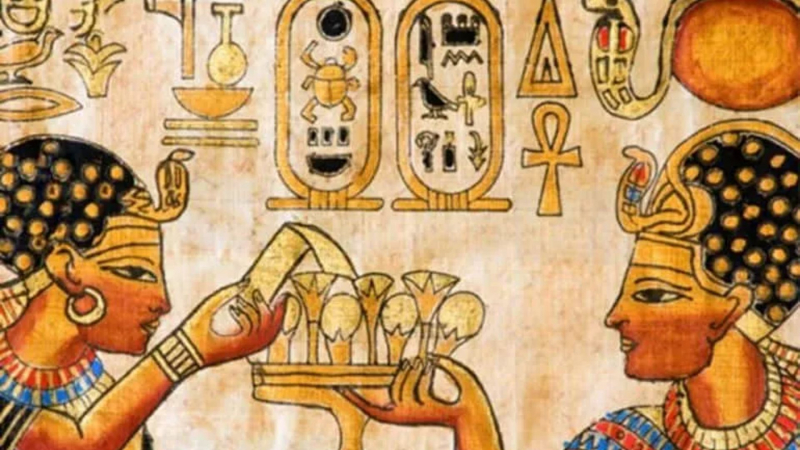
realmofhistory.com -
Drawings have long been used to tell stories; in fact, cave paintings from 30.000 B.C.E. have been discovered in Spain and France. However, it would take thousands of years for the earliest writing systems to emerge from Egypt and Mesopotamia, when pictures and paintings would eventually develop into the first written language.
Language is one of the most important ancient Egyptian innovations, they pioneered the skill of writing to express their ideas, at first the Egyptians used drawings and pictographic signs but ultimately after a few of thousands of years, they invented 24 alphabets (Where Each Symbol Represents a Sound Rather Than a Whole Word), about 3200 B.C.E, this caught on with Egypt's neighbors the Phoenicians who made their own alphabet which spread throughout the near east This influenced speech and writing and served as the impetus and basis for alphabets throughout the ancient world. The discovery of the Rosetta Stone in 1799 A.D. allowed for the disclosure of all of this knowledge. The ink was first used to write on papyrus by the ancient Egyptians in 3000 B.C.E., who were able to use their imagination to produce works of immortal literature like "The Pyramid Texts," "The Coffin Texts," and "The Book of the Dead" that reflected their emotions, legends, myths, adventures, and religious ideas.
Pictograms were the foundation of the Egyptian writing system. Pictograms were straightforward representations of the words they stood for, but they had certain drawbacks. With the addition of other components over time, the Egyptians were able to write out names and abstract concepts, including alphabet-like letters that stood for specific sounds and other characters. They have several languages over the years, including:
- Archaic Egyptian (before 2600 B.C.E.)
- Old Egyptian (2600–2000 B.C.E.)
- Middle Egyptian (2000–1300 B.C.E.)
- Late Egyptian (1300–700 B.C.E.)
- Demotic Egyptian (7th century B.C.E.–4th-century C.E.)
- Coptic (3rd– 12th-century C.E)
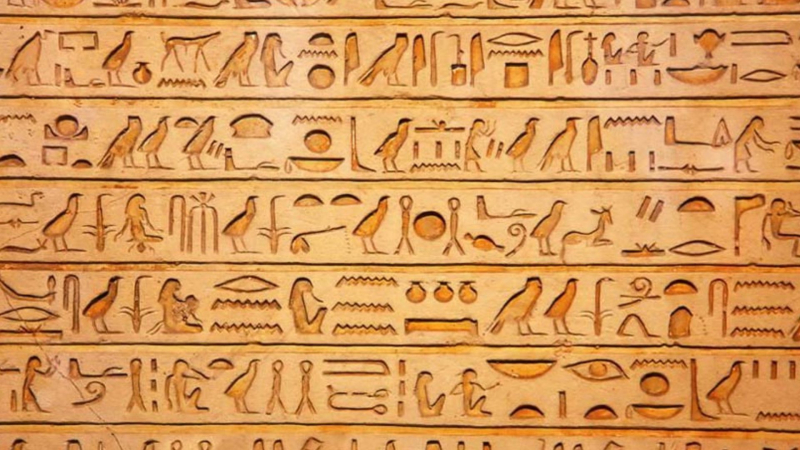
egypttoursportal.com 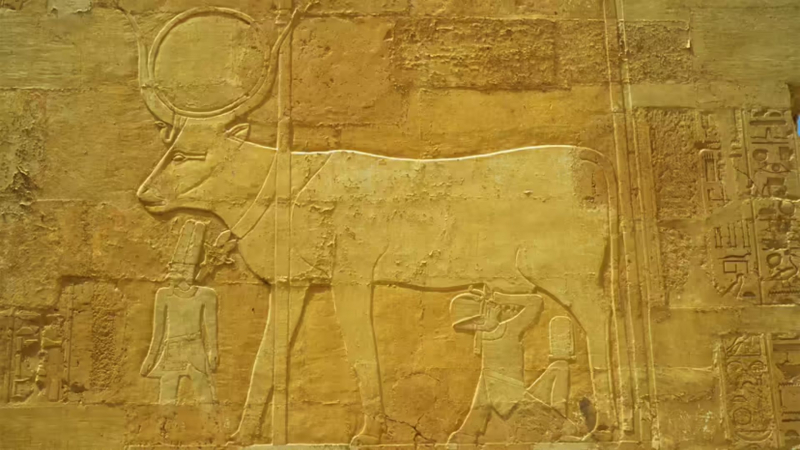
Ancient Egyptian heiroglyphics adorn the walls of the Temple of Queen Hatshepsut near Luxor, Deir El-bahri, Egypt. - WOLFGANG KAEHLER/LIGHTROCKET/GETTY IMAGES -
The Greeks are frequently credited with creating mathematics in history books. Although they were adept at mathematics and astronomy, they actually learned these skills from the Egyptians. The earliest known use of a decimal system was in 3100 B.C.E. The ancient Egyptians were very talented mathematicians; they were very proficient in addition, subtraction, multiplication, and division; they were also the first to invent basic and complex fractions, as evidenced by traces found on a papyrus written in 1650 B.C.E.
The key distinction is that Egyptian geometry and arithmetic were primarily employed for practical purposes, such as measures, economic transactions, and how to build pyramids and cut rocks. Mathematics was not thought to be a theoretical science. Their mathematics was more useful than that of the Greeks or Mesopotamians. Egypt is where the oldest geometric records first appeared since they developed a number of methods for performing the computations that we still use in current computing.
Using their sophisticated understanding of architecture and the physics underlying triangles, squares, quadrangles, and other shapes for measuring the land, the ancient Egyptians also possessed a gift for building some of the most inspirational monuments the world has ever seen. The magnificent three Giza Pyramids, the Great Sphinx, the entire city of Karnak, and a sizable number of beautifully made monuments that have withstood the test of time are just a few examples of the incredible constructions they were able to construct. In addition to using copper piping in 3000 BCE, precise surveying in 2700 BCE, and the astronomical calendar in 2400 BCE, which we still use today due to its accuracy and regularity, the Ancient Egyptians were the first to create custom-made bricks of the same size and cement.
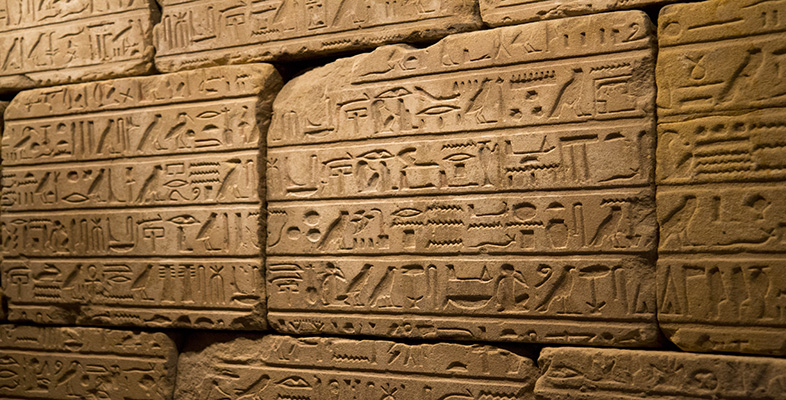
Egyptian mathematics - OpenLearn - Open University 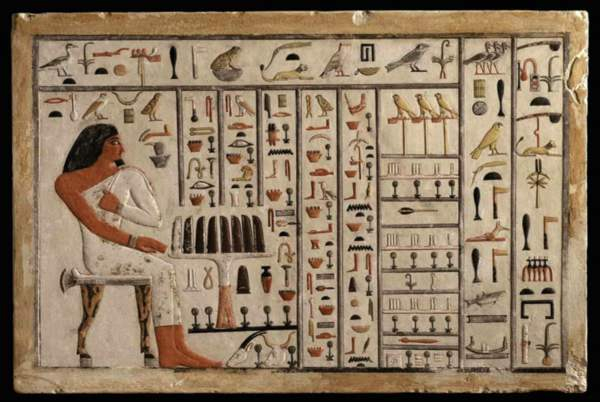
History and Numbers - EscherMath - SLU Math -
The new beauty obsession that emerged as the civilization advanced benefited people other than just Egyptian women, and technologies other than cosmetics were also produced in Egypt. Records from as far back as 5000 BC show that there were individuals employed to trim and maintain the hair and beard using pointed flints and shells, making ancient Egypt another location where the earliest barbers were discovered. Trends, as today, were subject to change: it was trendy to be clean-shaved at times, while long hair and beards were popular at others.
To that aim, the Egyptians may have devised the earliest shaving instruments, a set of sharp stone blades set in wooden handles, which were eventually replaced by copper-bladed razors. They also created the profession of barbering. Even when barbering became a profession, men still revered barbers as skilled craftsmen. Some of the early barbering was done by priests or doctors because it served a ritualistic or medicinal purpose. While the common people had to go to one of the city's street barbers to receive a haircut, a tradition that is still practiced in many cultures today, the Egyptian elite frequently had their own live-in barber to cater to their grooming needs, much like a butler, or at least had one make home calls!
Perhaps the first ancient people to give their hair much attention were the Egyptians, or perhaps not. In any case, they disapproved of hair because it was unclean and because long hair and beards were uncomfortable in the oppressive heat of their own area. As a result, they frequently shaved their faces and heads or chopped their hair short. Every three days, priests shaved their complete bodies because they were reportedly particularly repulsed by hirsuteness. Being shaven was trendy for much of their history while being chubby evolved into a sign of low social standing.
Interestingly, they continued to be fascinated with facial hair, or at least the illusion of having it. Even more bizarrely, Egyptian queens and monarchs occasionally wore wigs and artificial beards that were made from sheared hair and sheep's wool. The false beards came in a variety of styles to reflect the wearer's dignity and social standing. King's fake whiskers were worn to extravagant lengths and were squared off at the end, whereas commoners wore little fake beards that were around 2 inches (5 centimeters) long. The long, luscious beards of the Egyptian gods were twisted up at the tip.
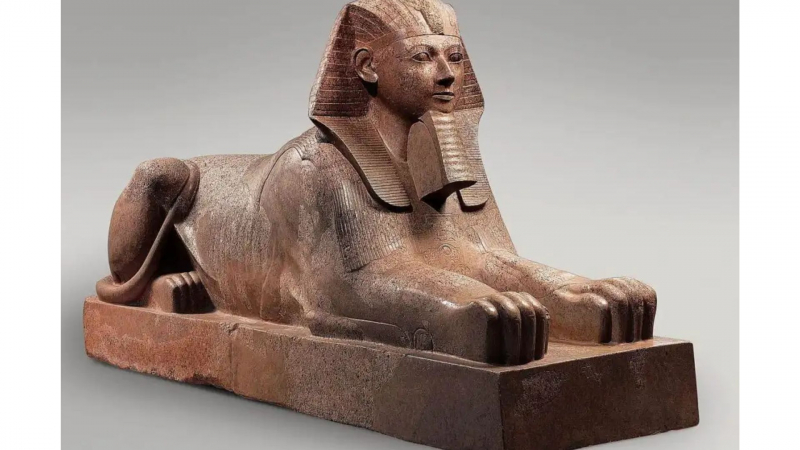
Sphinx of Hatshepsut, notably wearing a false beard, 1479-58 BC - The Metropolitan Museum of Art, New York 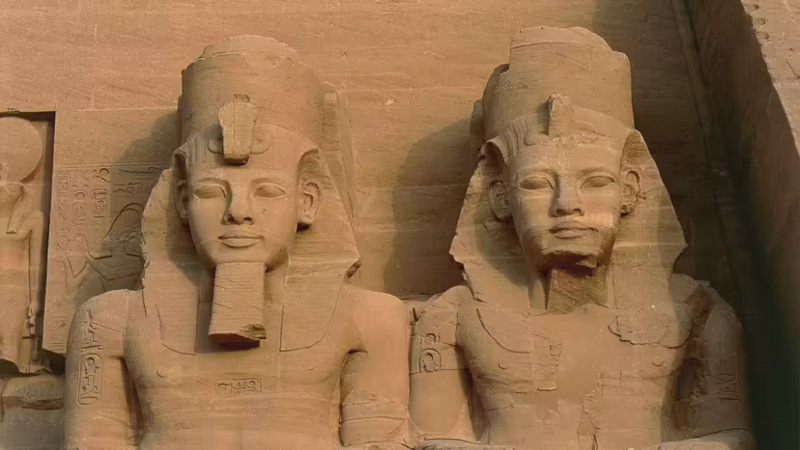
False beards like the one this statue of Rameses II at the Temple of Hator is sporting were popular in ancient Egypt. - DEA/A. GAROZZO/DE AGOSTINI/GETTY IMAGES -
The Egyptians were the first to use boats for local and international trade and commerce. Egypt was a major commerce hub in the Mediterranean, exporting and importing items such as cattle, wine from Asia, precious stones from Persia, and copper from Senia. They were able to establish strong trading ties with Sudan, Phoenicia, Crate, and Persia. They were the first to construct their own navy by utilizing sophisticated knowledge of aerodynamics and shipbuilding skills. In 1160 B.C.E., they also developed the first known geologic and topographic map. They were the first to investigate and invest in the full potential of agriculture and farming as they studied the Nile's cycles, which led to the development of the earliest irrigation systems and the use of sickle blades and plows drawn by oxen to soften the parched soil.
Although historians are unsure of the exact origin of the plow, evidence suggests that the Egyptians and the Sumerians were among the first civilizations to adopt it circa 4000 B.C.E. Those plows were undoubtedly in need of refinement. The plows, which were probably made from adapted hand tools, were so light and inefficient that they came to be known as "scratch plows" due to their inability to penetrate the earth deeply. Additionally, the plows were powered solely by manual labor. For instance, wall murals depict four men working together to move a plow through a field - not the best way to spend the day in the intense Egyptian sun.
That all changed about 2000 B.C.E. when the Egyptians connected their plows to oxen for the first time. Early designs were attached to cattle horns, but they interfered with the animal's ability to breathe. Later versions added a strap system and were far more effective. The plow revolutionized agriculture in ancient Egypt, making farming easier for the Egyptians than maybe any other society at the time.
The plow undoubtedly made planting crops much simpler, but farming was still laborious labor. Farmers had to stoop over all day in the scorching sun while tilling the earth with short-handled hoes. In addition, the Egyptians harvested their crops with scythes and carried seeds in baskets. However, the pigs and sheep they employed to trample seed into the ground may have been the most inventive farming implements.
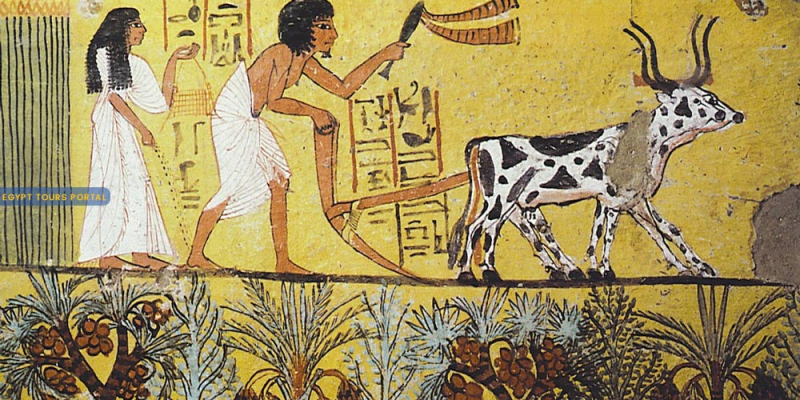
The plow revolutionized farming in ancient Egypt. - ART IMAGES/GETTY IMAGES 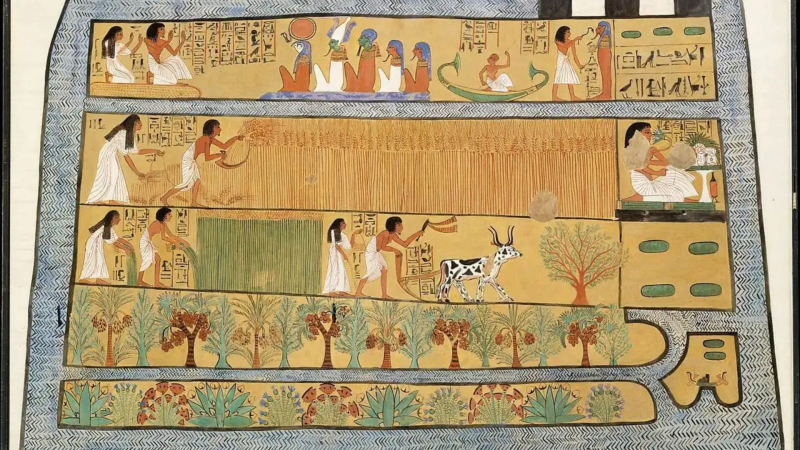
Sennedjem and Iineferti in the Fields of Iaru, 1922 AD; original 1295-13 BC - The Metropolitan Museum of Art, New York

















